JDAMs And GLSDBs - Wunderwaffen Or Vaporware?
A brief deep-dive into these two systems, and what chances they stand against Russia's layered AD.
The U.S. has announced a weapons package to Ukraine which includes the JDAM bomb system. The JDAM system is basically an adaptation fitted to older style Vietnam-era Mark 80 series ‘dumb bombs’ (no guidance) which turns them into guided bombs.
There are so many wrong-headed generalizations and jumps to conclusions about these upcoming weapons systems. Let’s explore what this actually means for Russia, and what real consequences can be expected, point by point.
Firstly, a basic primer on what the ‘JDAM-ER’ promised to Ukraine really is. It’s a conversion package which takes an old, basic US ‘Mark 80’ series non-guided bomb and puts a GPS package onto it, with foldable wings, which allows the bomb to ‘glide’ to its target by way of GPS coordinates (and internal INS, but we’ll get to that later). This Mark 80 series has four different types of bombs, 250lbs, 500lbs, 1000lbs, and 2000lbs—and they can all be converted into JDAMs.
This allows the US to quickly convert thousands of old and useless ‘dumb’ bombs into more modern ‘guided’ versions. The platform is extremely cheap, even with the addition of the guided components, and so in that respect it’s perfect for Ukraine. The ‘ER’ designation at the end of JDAM-ER refers to an ‘extended range’ version, which can go upwards of ~72km.
But here’s the catch, the JDAM is a glide bomb—this means it has no propulsion whatsoever, it simply glides to target, always bleeding speed and altitude along the entire way. Think of a thrown paper plane:
This means that to maximize distance, you have to drop it from as high an altitude and as fast a speed as possible.
Many AFU supporters on the net have frothed over the 72km+ range, believing that the bomb will give Ukraine unparalleled capability to strike deep behind Russian lines, completely ignoring the fact that its range is entirely conditional on how the bomb is released.
To hit the full 70km+ range, the host plane would have to be flying very fast to give the bomb a high initial speed, and drop it from 35,000ft altitude.
The problem here is obvious: any AFU plane that ascends to 35k feet would be instantly lit up on every long-range Russian radar screen. This is why neither side in this conflict dares fly above a few hundred feet from the ground. If you drop the bomb from let’s say 5,000ft, its range may top out at a pitiful 10km or less, etc.
But there’s a few nuances to this:
Firstly, there could be the possibility, with really good pilots, that one can creep up towards the frontline at an extremely low altitude—below radar coverage—then very rapidly climb up towards 30k+ feet to release the ordnance, followed by an immediate dive back below radar coverage.
This is conceivable, in theory: and modern jet fighters could climb to 30k in maybe 60 seconds or less, like so:
But there’s a few hitches. Firstly, even the 60 seconds it could take to achieve this climb is a really long time for long-range AD like S300/400 to be able to spot and engage you. During the entire climbing phase, you’ll be on their radars and they’ll be honing the firing solution onto you.
And the biggest thing: by climbing so steeply and rapidly, you will bleed off all your speed. By the time you reach the 30k+ required, you’ll likely be going less than 150-200knots and, after straightening out, will now need an additional ~60 seconds—if not longer—to accelerate the JDAM to its ideal velocity, prior to release; remember, it has no propulsion of its own at all.
In short, this could put you at a theoretical 2 minutes of time stuck in the red ‘danger zone’ of detection (plus additional time for your subsequent ‘dive’ back to safety).
This should give a lot of time for S300/400 operators to fire on you. And even if you manage to dive below radar horizon afterwards, the missile may already be close enough (depending how far away it’s fired from) to have switched to its own terminal guidance. Depending on which missile is used: an S300 can have terminal IR guidance, which means the missile will seek the target by thermal (heat) emission, even if the target is no longer within radar view of the radar base unit far away.
S400 missiles on the other hand have full blown active radar terminal guidance, which means they no longer even need the original tracking/targeting radar on the ground, but will now be tracking the AFU plane with their own in-built nose-cone radar. And it won’t matter how ‘low’ the target tries to go at that point.
An S400 missile’s speed is around 2200mph (3500km/h+), or over Mach 3. So, let’s say the unit detects this hypothetical Ukrainian Mig-29 at max range of around 400km. It would take the S400 missile ~6-7 minutes to reach the target, which could give the plane enough time to evade.
But if the S400 system is anywhere within 100-200km of the detected launch, it brings that down to 2-3 minutes. And as we established, the plane may take nearly 2 full minutes or more of being in the ‘detection zone’ to perform the maneuver required to release the JDAM-ER for a max range hit.
So, if the Russian long range system is anywhere within 100-200km, then they will have a very good chance of shooting down the Ukrainian plane. If it’s anywhere closer than 100km then it would be an almost definite kill. And there’s good chance that there will always be a Russian long range system at least somewhere 100-200km away, if not much less.
Short range systems like Pantsir-S1 and Tor-M1/2 can generally engage targets in the 15-30km range at the most. Medium range systems like BUK around ~30-42km. That means the plane could theoretically launch the JDAMs far out of SHORAD (Short Range AD) range—he would just have to hope that Russia’s layered/integrated long range system is not somewhere in the general region as well.
But what if Ukrainian pilots compromise between range/risk? They could theoretically loft the planes only up to 10-15k feet and release the bombs for maybe half the range of ~30km+. But the issue with this halfway measure is: what would be the point of using a JDAM to reach 30km when they already have a plethora of artillery systems that can do the same thing far cheaper and easier?
Most artillery caps out in the 25-30km range, with a few special RAP/Base-Bleed munitions which can go a tad farther. But thus far, the AFU has had only one weapon system that could reliably go beyond 70km+, and that’s the HIMARS.
Logically, one would think the whole point in obtaining these new JDAM-ERs would be to give Ukraine a solid new method of hitting those HIMARs ranges. It’s difficult to imagine they’d want to settle for merely using the JDAMs in an artillery style role.
Sure, they still would have advantages in that the bombs are exponentially more powerful than artillery. The 500lbs Mark 82 has about 190lbs of explosives, whereas the typical M795 155mm artillery projectile is filled with ~25lbs of explosives.
Also, the JDAM would be much more accurate, as it’s GPS/INS guided, unless you compare it to the GPS-guided Excalibur artillery round with the same accuracy.
Still though, it feels like far too much effort and risk to basically throw a more powerful artillery round at the same distance. After all, Ukraine doesn’t have many planes left; it wouldn’t be worth risking the last few just to heave a round at something that regular artillery could hit.
So I could only imagine they want the JDAMs for max range. After all, it’s why they’re specifically acquiring the JDAM-ER (extended range) model. That means the Ukrainian pilots will be at severe risk trying to lob these things from 35k feet, which leads me to conclude this weapon will not be effective or something to much worry about.
Secondly, we haven’t even mentioned the bomb itself in this regard. Let’s suppose for an instance, the Ukrainian pilots are able to successfully loft it from 35k feet and evade detection. The JDAM itself is a huge, clunky, old-fashioned Vietnam-era bomb. It’s not designed to be ‘low profile’ or ‘low observable’ or ‘stealthy’ or any other of these MIC buzzwords.
Further, it is slow, has an extremely predictable glide path with zero evasive or ‘juking’ capabilities like some modern missiles possess. It will glide subsonically, at an easily predictive path, bleeding speed all the way. In short: it should be one of the easiest possible birds to kill for Russian AD of all the types of munitions currently in use in Ukraine.
Recall, Russian AD now regularly intercepts even HIMARS missiles, sometimes at 100% intercept rate—and these travel at nearly Mach 3.0. How difficult would a giant, clunky bomb floating at Mach 0.4 or less be to shoot down?
Sure, the CIA mission planners will specifically choose to use it where Russian AD may be thin (by way of their satellite recon). But as a generality, these things should not pose much threat at all for the variety of reasons given above.
And the fact that AFU barely has any planes left means they will be exposing their airforce to existential risk each time they attempt to loft these things from the required altitude—barring any sudden mass F-16 deliveries, or something like that. But, just as this U.S. congressman recently said, the F-16 would be completely useless against Russian AD. Watch this video at the 1:40 mark.
Additionally, the JDAM’s accuracy is over 100ft CEP if the GPS is jammed, as it then relies completely on the INS (Inertial Navigation System). And Russia has GPS jamming in much of its most critical areas, which could mean if the JDAM is used against any ‘important’ Russian targets, its accuracy will be very poor.
Lastly, due to how few planes UA has left, and the fact that probably 4 maximum JDAMs will be fitted per plane (similar to F-16), it would not allow Ukraine to conduct the type of long range ‘saturation’ strikes they enjoyed with the HIMARS, of which they have 20 systems total, and which fire 6 missiles each (not to mention the HIMARS’ range is greater than the JDAM to begin with).
But since we’re on the topic of HIMARS, let’s turn to the GLSDB hybrid bomb/missile, which is the other buzzy vaporware Wunderwaffen currently slated to ‘turn the tide’ of the conflict.
The GLSDB (Ground Launched Small Diameter Bomb) is basically a HIMARS missile with a glide-bomb fitted to the top of it. The purpose of doing this is as follows: the HIMARs themselves have a max range of 80-90km. But if you fit a gliding bomb on top of the missile, shoot the missile high up in the air and release the glider, it can get an even greater extended range—which is 150km.
It can theoretically hit any part of Russian-controlled territory of Donbass if fired from near the contact lines, as seen below:
The glide bomb portion (SDB) is not too dissimilar from the JDAM discussed above. Although its weight is ~250lbs vs. the JDAM’s 500lbs (JDAMs have different variants, but the more popular 500lber is likely the one Ukraine will get).
The SDB is also GPS/INS guided, so no difference there. In terms of its profile, since it’s smaller and a little more modern, it will present a smaller radar cross-section. And since the missile releasing it will be going much faster than the plane subsonically releasing the JDAM, the initial velocity of the GLSDB will be much greater.
However, just like with the JDAM, its speed will slowly bleed off. Since the HIMARS rocket motor’s max range is 90km, and the GLSDB is listed at 150km, you can assume the remaining 60km difference would be entirely traversed by gliding down.
So, even if it’s released supersonically, after dozens of kilometers, it will bleed a lot of speed and most likely end up subsonic by the time it reaches the target.
Thus, its interception vulnerability is still fairly high BUT, the difference is that Ukraine would theoretically have much greater ‘saturation’ potential with this. As mentioned earlier, with ~20 HIMARS/M270 vehicles which can launch 6 each (M270 can do 12), there is far greater ability to saturate, making this weapon far more potentially deadly than the JDAM.
However, apparently the U.S. military itself doesn’t even yet operate the GLSDB. They’ve tested them in the past, but they don’t have any current operational systems in service. And according to various sources, the Ukrainian HIMARs are therefore likewise not compatible with them and would take ‘up to 9 months’ to get them retrofitted.
So, how do we reconcile that with the fact that pro-Ukrainians (and some reputable Russian channels as well) claimed that Mariupol was already struck with GLSDB’s last week? From the very moment those ‘strikes’ occurred, I was vocally skeptical that GLSDB’s were utilized, and I remain so.


Firstly, even if they were GLSDB, there has been zero confirmation of any successful hits—only ‘sounds’ of explosions which was likely them being intercepted. If that’s the case, it would be an extremely favorable outlook for Russian AD’s ability to handle these bombs.
The only unverified report which seemed to claim a possible hit was that of the Mariupol airport, which is actually several kilometers west of Mariupol city proper.
Some have stated it had to be GLSDB because nothing else could have reached Mariupol from Ukrainian territory. But it can be seen here that even Ukrainian-occupied Ugledar is a mere 80km from Mariupol:
Regular, basic HIMARs missiles have a range of ~90km. So certainly they could have reached—no need for GLSDB.
Lastly, if they had actually been supplied with GLSDB’s already, you would think they’d attempt to hit more than a few insignificant, militarily useless civilian targets in Mariupol. Where are all the terrifying ‘mass, disabling strikes’ on ‘Russia’s rear’?
And why haven’t there been further strikes since then? This hit was already close to two weeks ago. Why aren’t these magical GLSDB’s flooding every frontline, destroying all ‘Russian command centers’ like they were hyped to do? Most likely they don’t have them yet—and there’s good chance they won’t get them.
If they do, it’s likely that they’ll prove about as effective as the AGM-88 HARM(less) missiles have proven. A slow-moving, unmaneuverable glide-bomb will present an easy target for AD even in attempted saturation mode. It’s not a cruise missile which can smartly fly ‘under the radar’—these things will be released extremely high up and will float down like a paper airplane. It’s about as ideal a target as Russian AD can possibly hope for. The only conceivable threat is a saturation attack fired from many HIMARs units at the same time.
Also, it should be mentioned that for both of these systems, it opens up a far larger variety of vectors from which Russian AD can intercept them. When a target is traveling supersonically, let’s say Mach 2-3 range, it’s improbable to intercept it if the AD system is positioned at a vector which makes it difficult for the intercepting missile to ‘catch up.’
Most intercepting missiles, like those of the S400 mentioned earlier, fly in the range of Mach 2-3 themselves. So when you get a missile like a HIMARs that flies at Mach 2.5, the best chance you have of intercepting it is if it’s flying ‘roughly’ toward the general direction of the AD system. This would be a direct vector that’s easy to intercept.
But an oblique vector, where the enemy missile is flying parallel to the hypothetical S300/400 will be much harder. There’s some advanced trigonometry to this, but we’ll simplify it in the most basic possible terms.
In the above very basic diagram, you can see a HIMARs M31 missile traveling at Mach 2.5 in a direction parallel to the S300/400 unit. Let’s say the distance between them might be several dozen kilometers, etc.
The S300/400 missile also traveling at Mach 2.5 will have a very hard time ‘catching up’ with the HIMARS one, unless it were flying ‘directly over’ the S300/400 unit, or fairly adjacently close.
But now:
If the JDAM (or GLSDB for that matter) is flying in the same parallel vector, but it’s only going a small fraction of Mach 1—which is what the bombs will slow down to—you can see that even if the plotted vector is distantly parallel to the S300/400 unit, the missile traveling at Mach 2.5 which is several times faster, will be able to ‘catch up’ with the target.
So basically: it means that JDAMs and GLSDB’s will allow a far greater envelope of engagement and interception vectors for Russian air defense systems of all kinds, whereas faster missiles like the HIMARS enjoy the ability to exploit certain ‘chinks in the armor’ that lie in between overlapping AD system’s radar nets.
In conclusion: while the GLSDB poses more danger, it’s also a far more untested system, which could take much longer to field. As always, it’s not an ‘all or nothing’ binary argument. The systems are not completely worthless—nothing is, in war. They may even get a few strikes, particularly early on before Russian engineers are able to update their new target tracking profiles into the AD radar unit computers, as they recently did with the HIMARS.
But certainly, neither of the systems will prove to be ‘game changers’ of any kind—except of course, as per the AFU’s usual M.O.—against civilian targets in non-military directions which may have radar gaps.


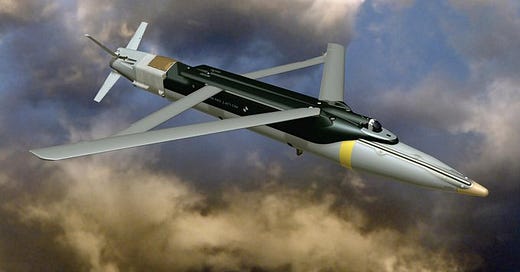



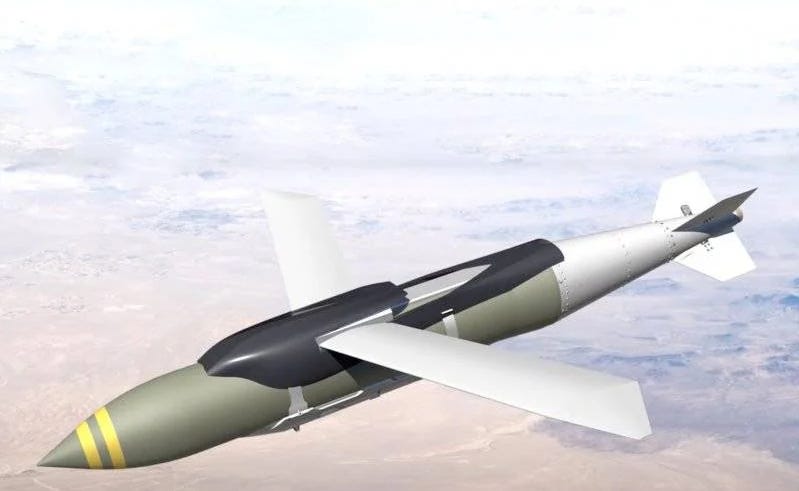






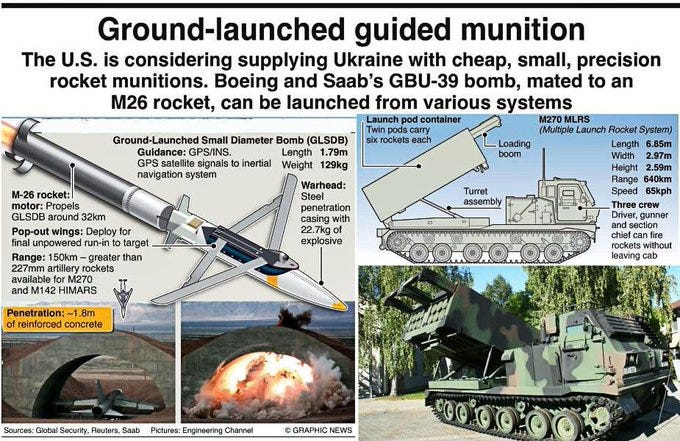

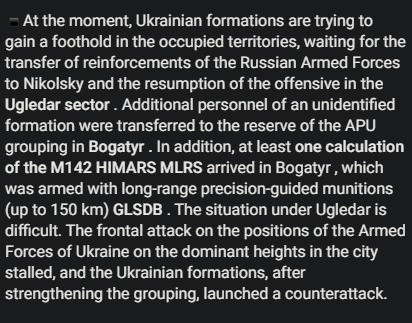
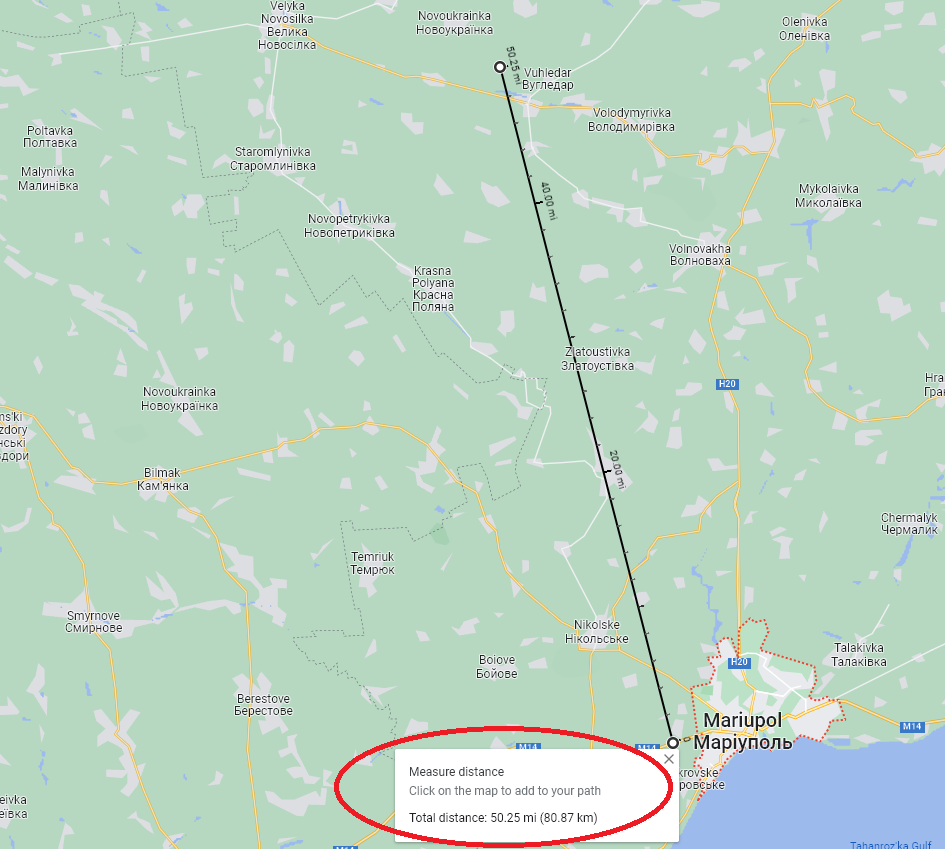



Great analysis, as usual. I’m wondering if we will be sending dangerous gas stoves along with the JDAMs to finally “turn the tide.”
If the HIMARS has been largely defeated by Russia AD, then these projectiles will fare far worse. The volume of them will be limited for all the reasons noted. It is not a stupid idea if you want to use these as an artillery substitute since 155 MM shells are gone, but the volume of these and the lack of explosive footprint will make them pretty ineffective for the ones that get through AD. Its way too little, way too late. The West did not understand Russia's capabilities economically and militarily and were not prepared for this war. They are stupid, arrogant and ignorant. Dangerous too, mostly to their own people.